Fujifilm X30 Review: Sharp But Struggles in Low Light
Our Verdict
Fujifilm's X30 is a solid bridge camera that delivers high-quality pictures, but it suffers from iffy Wi-Fi and problematic autofocus.
For
- Bright and abrupt pictures in brilliant light
- Handsome design
Against
- Dull autofocus in low light
- Frustrating interface
- Oversensitive LCD shutoff sensor
Tom'south Guide Verdict
Fujifilm's X30 is a solid bridge camera that delivers loftier-quality pictures, but it suffers from iffy Wi-Fi and problematic autofocus.
Pros
- +
Bright and sharp pictures in bright lite
- +
Handsome design
Cons
- -
Boring autofocus in low light
- -
Frustrating interface
- -
Oversensitive LCD shutoff sensor
With its industrial, retro pattern and solid build, the $599 Fujifilm X30 comes across every bit a dependable span camera that packs semipro photo quality in a meaty body. But although it delivers swell photos well-nigh of the time, the X30 suffers from several flaws that, together, almost ruin the overall experience.

The camera carries a 12-megapixel, 2/three-inch sensor and 4x zoom lens (28-112mm equivalent) with a large max aperture range f/2.0 (broad)-f/ii.8 (tele). With its size and specs, information technology has a lot of competition among bridge cameras. For comparison, Canon's rival G7 Ten has a twenty-MP, 1-inch sensor (which is larger) and a 4x zoom (24-100mm), f/1.8-f/2.eight lens. Another heavy hitter in the category, Sony's RX100 Iii, has a 21-MP, 1-inch sensor and a 3x zoom (24-70mm), f/1.viii-two.8 lens.
Design: Pretty, Only Frustrating
Fans of old-school pattern will be pleased to see that Fujifilm has not strayed far from its retro manner for the X30's chassis. A black leatherette band stretches around the matte-silver magnesium body, giving the camera a handsome, industrial expect. The X30's plastic lens cover looks similar an inch-deep bottle cap that you twist and pull to remove.
More: Best Span Cameras
At 4.seven x 2.8 10 2.4 inches, the X30 easily fit in my medium-size satchel, but it was heavy enough (xiv.9 ounces, including the battery) to exist a pain on my shoulders. It took me a while to figure out how to turn on the X30, since in that location isn't a power button. Instead, you lot have to rotate the lens' zoom ring until it clicks.
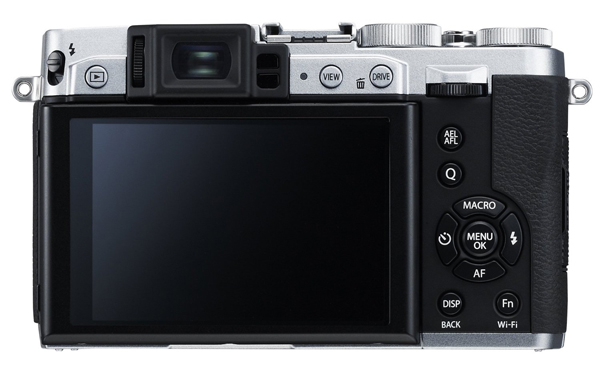
Once that'southward done, you'll find virtually of the controls you'll need within like shooting fish in a barrel reach, thanks to the camera'south iii dials and xiv buttons. A defended knob for exposure compensation sits beside the Way dial (for selecting modes such as Automobile, Manual or Aperture Priority), with a 3rd bike next to the drive button to adjust aperture or shutter speed values in the relevant modes. Having this many dials on the X30'due south relatively meaty torso fabricated information technology a fiddling crowded. I sometimes turned the exposure compensation bike by accident when I was trying to adapt the Mode dial.
New to the X30 (i.e., not found on its predecessor, the X20) is a 0.4-inch, 1024 x 768-pixel OLED viewfinder that sits above the iii-inch LCD. It offers a DSLR-like experience in framing pictures, and was impressively smooth every bit I panned effectually scenes. You tin can likewise use the tilting 640 x 480p LCD to frame bad-mannered shots, but it doesn't flip up or out for easier selfie shooting every bit with other cameras, such as the Sony RX100 III.

Thank you to the hot shoe atop the X30, y'all tin can attach an external flash or microphone for better audio. Fujifilm offers 3 shoe mount flashes for the X30, ranging from the $99 EF-20 to the $169 EF-42 and the $180 EF-X20); a $109 MIC-ST1 stereo microphone; and several lens hoods.
Image Quality:
The Fujifilm X30 produced bright pictures with precipitous detail in good lighting, but failed to evangelize in low light.
Bright Light: Solid Color Reproduction and Great Clarity
I loved how articulate the X30's pictures turned out in well-lit situations. Red buildings and blue heaven in my wide shots of Manhattan'south Flatiron Commune were gorgeous, thank you to the vibrant hues and articulate details, such every bit street signs and film titles on a theater's facade. Colors were accurate and not oversaturated.

The colorful lanterns at a holiday-market place stall in Union Square were similarly vibrant, and accurately rendered, while greenish leafage adorning the awning looked true. White tents in the dorsum-right corner of the image expect slightly diddled-out, but given how bright they were (to the point of hurting my eyes) in existent life, the X30 handled the situation capably.
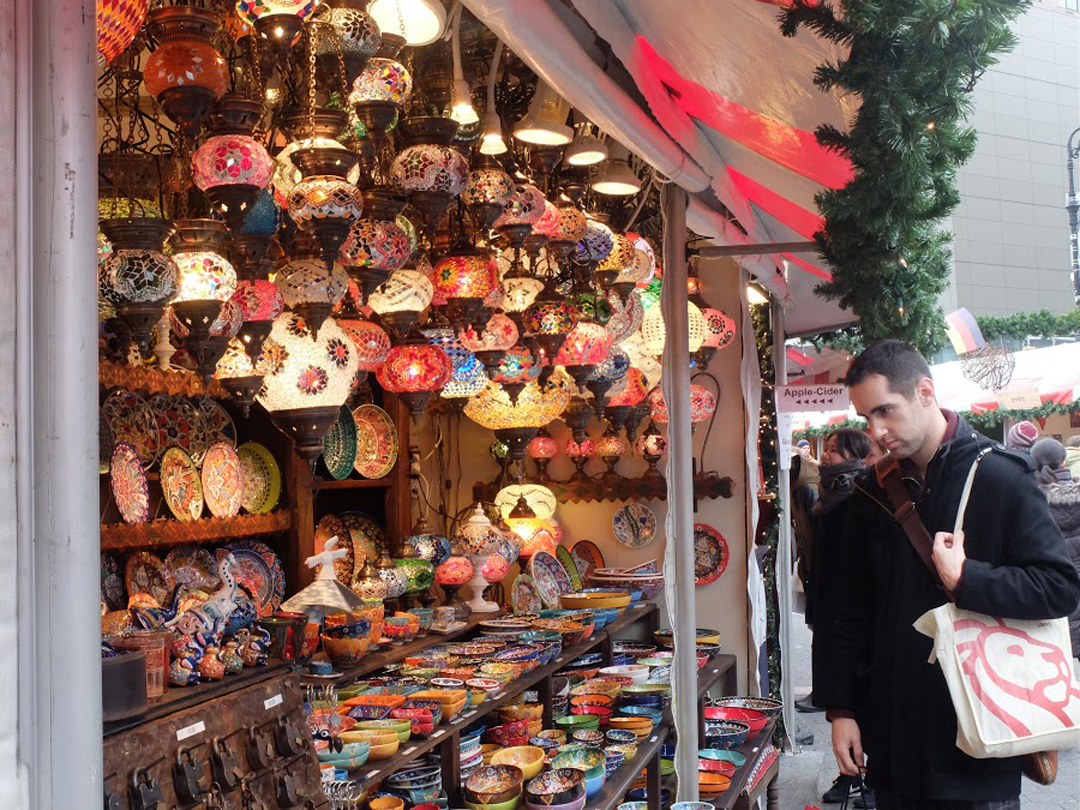
Indoor Photos: Authentic Color
The X30 handled the claiming of indoor lighting well. Close-upward shots of some roasted vegetables at a dinner political party were tack-precipitous, with a pleasing shallow depth of field, courtesy of the lens' ability to open up its aperture as large as f/two.0. (I used f/2.2 here.) Despite the yellow lighting at the event, the X30'southward tungsten white balance setting allowed the camera to accurately reproduce colors on items like red peppers and a green table cloth.
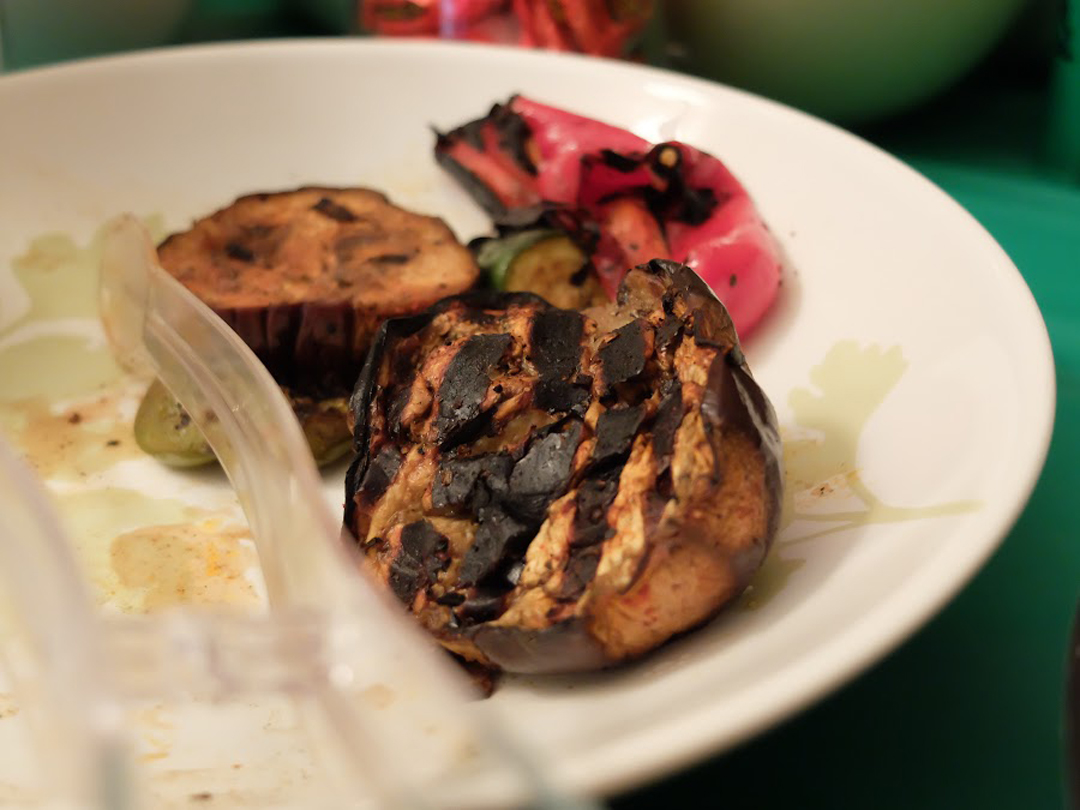
The X30 is solid at colour reproduction in general; it accurately captured shots of my guests, lit by incandescent calorie-free. Even when I shot with auto white rest, their skin tones looked true, as did their colorful outfits.
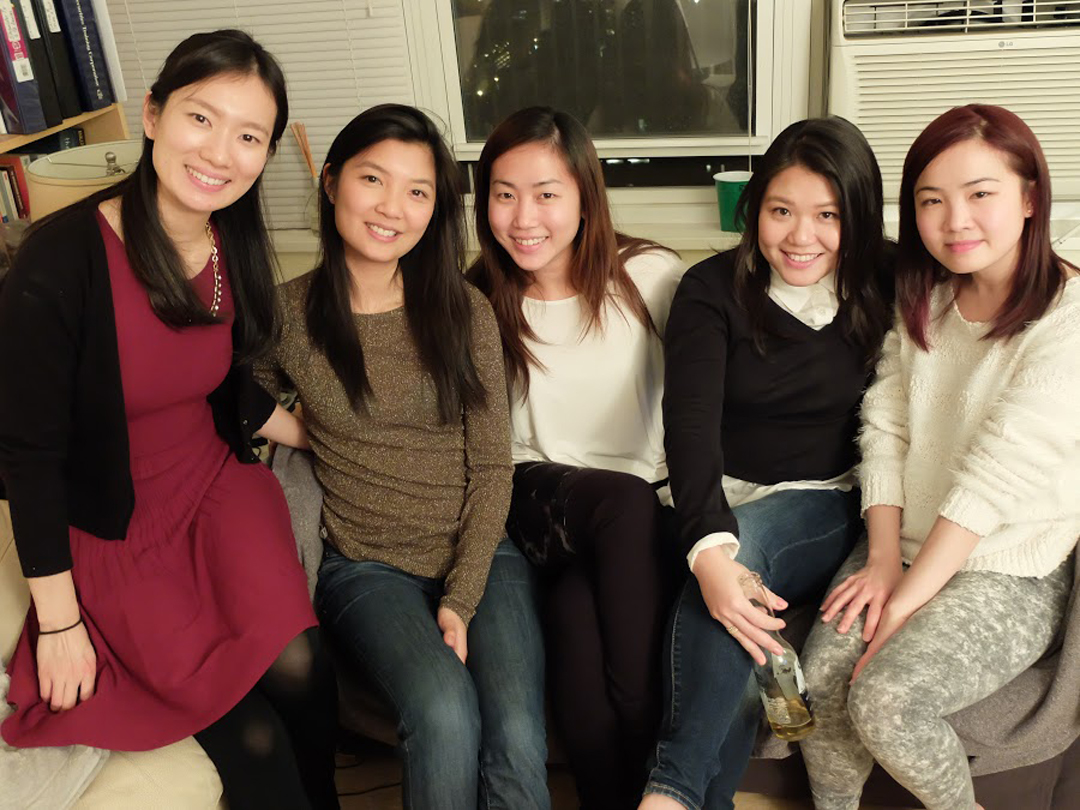
Low Light: Tedious Focus, Great Clarity
With the X30, I struggled to go a good photo in nighttime situations. Not only did the camera have forever to focus and process, but pictures that I somewhen snapped often turned out blurry (probably due to very slow shutter speeds). Given that the X30 has a top ISO calorie-free sensitivity setting of 12,800, I would have expected meliorate performance.

Aside from having to concord incredibly still, or place the X30 on a tripod or stable object, I was impressed past the X30'due south low-light images. In pictures I managed to snap without shake, the cityscape was bright, and colors such as the blue and blood-red lights on the top of buildings were accurate. Individual buildings' silhouettes were crisp, as were the outlines of windows. Despite the stark dissimilarity between the bright lights of the buildings and the dark heaven, at that place was no discernible regal fringing in the pictures.
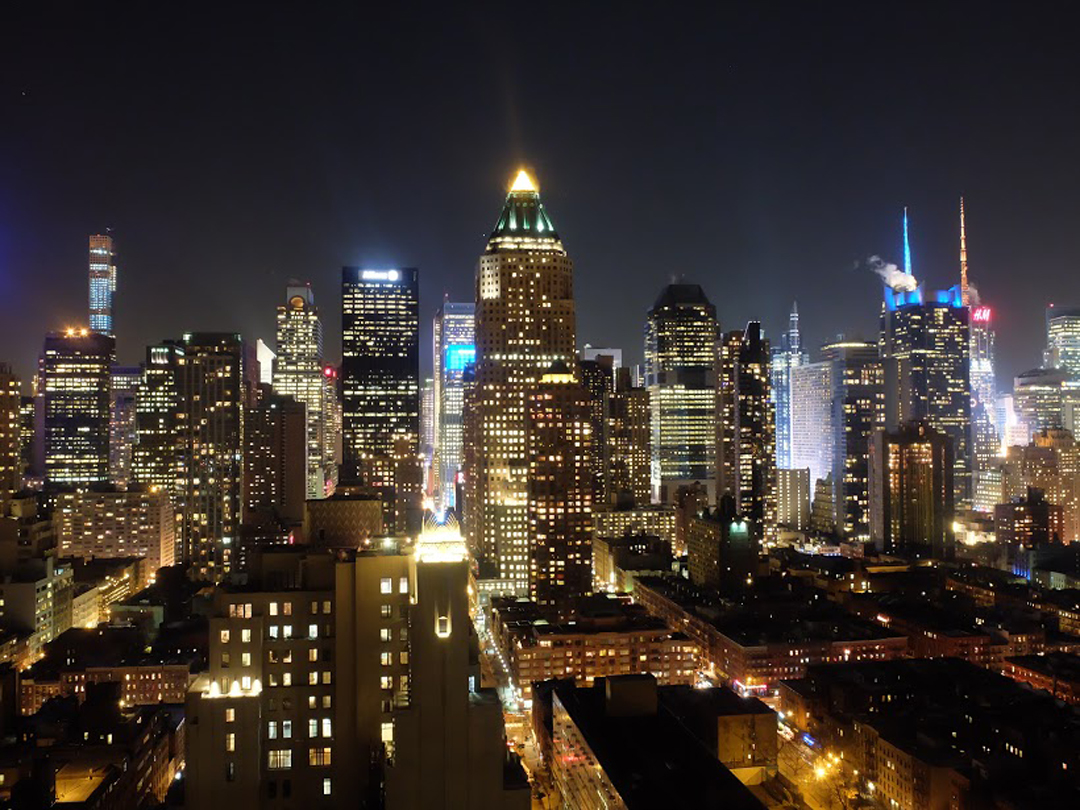
Autofocus and Speed: Struggles in Depression Lite
In general, the X30 was fast and responsive. When a scene was well lit, the camera focused on subjects near instantly. One time I got into a lower-lite situation, though, the photographic camera struggled to observe its focal signal.
I have an event with the X30's face-detection organization: You tin can't plough it on in modes such as Transmission, Program or 1 of the Priority settings. It is enabled simply in Filter, Advanced SR Auto and SP1 (Portrait) modes.
Fujifilm says the X30 can shoot at a whopping 12 frames per second (with autofocus and exposure stock-still at the first shot) in Continuous mode for upwards to 18 frames until information technology slows down to empty its memory buffer. That makes it 1 of the fastest cameras effectually. In a rapid-burn down shooting sequence of my fast-typing co-workers, the X30 snapped away without lag, pausing only afterward the 18th shot. That'southward impressive, although shots toward the finish of the series were blurry.
In low light, however, the lens struggled to latch on to any focal points, often taking more than x seconds of whirring back and forth to focus. That delay could price you a shot. I tried to snap Manhattan streets as I strolled home i nighttime, and despite continuing as still equally I could, my images came out blurry.

Granted, the shutter speed was very tiresome for a picture taken without a tripod, simply with no limits assault any of the levels (such every bit ISO or shutter speed), the camera should take opted for a faster shutter and a college ISO.
Video autofocus performance was better, with the X30 keeping multiple subjects' faces in focus as I panned across a line of New Yorkers waiting at a food truck.
Video Quality: Brilliant and Smoothen
The 1080p video I shot with the X30 at 60 fps was bright and smooth. Scenes of a rooftop game of ring toss were bright and articulate, with no discernible shutter roll, a geometric distortion that occurs when the camera tin can't continue upwardly with a moving object.
Even equally I played dorsum the clip frame by frame, the image quality maintained an adequate level of focus, with some blurring occurring only in panning scenes. This lack of shutter roll is perchance a benefit of the smaller sensor, since smaller fries can read information faster.
Notwithstanding, the X30 did produce very singled-out moiré, a false wavy pattern that happens when you're capturing fine, repetitive patterns. On the X30, the outcome was pronounced in video featuring a silver, perforated fence, but it was less obvious when I filmed the same fence with the $750 Canon PowerShot G1 X Mark Ii span camera.
Controls: All You Need, Inside Reach
With a total of three knobs and 14 buttons, the X30'due south chief settings are inside easy reach.
Thank you to its numerous dials and buttons, the X30 fared well on our test of how easy information technology was to access key settings.
| Setting | Push presses to access | Function |
| Shutter | 0* | Length of exposure |
| Aperture | 0* | Amount of low-cal permit in |
| ISO | two | Light sensitivity |
| Focus way | 5 | Signal or points used for focus |
| Light metering | 4 | Role of prototype with optimized exposure |
| Custom white balance | 11 | Tune overall color cast of image |
| Exposure compensation | 0 (dedicated punch) | Set motorcar exposure to exist darker or lighter |
| Wi-Fi sharing | thirteen | Send images to smartphone, activate remote viewfinder |
| Video recording | 0 (dedicated button) | Switch from photo to video and back |
| Play | 1 | View images or videos you've shot |
| Delete image | 1 | Remove image from card |
| Photo capture resolution | 4 | Number of megapixels |
| Photo capture quality | 4 | Amount of JPEG compression/detail, or RAW |
| Video capture quality | 13 | Resolution, frame charge per unit and amount of pinch/detail |
| Drive | i | Unmarried photo, burst, timer, etc. |
* Measured in the relevant priority style
Ane frustrating quirk was the X30's oversensitive eye sensor next to the electronic viewfinder. It'southward designed to turn off the LCD monitor and activate the viewfinder when it detects something (typically, your eye) hovering in front of it. But information technology is and so sensitive that whatever time my fingers or random objects came within 3 inches, the LCD turned off. This was extra abrasive when I was trying to change settings in the camera'south carte du jour and the LCD kept turning on and off.
Battery Life: Minimal
According to Fujifilm, the X30 is rated for 470 frames with the LCD on and in Car mode. During my testing, the photographic camera took just 270 pictures and nine videos (for a total of 6 minutes) before conking out. That provided me with just enough juice for 3 days of shooting before I had to recharge the X30. Simply an aggressive shooter could accident through the battery in a day.
Wireless Capabilities: Problematic Setup, Smoothen Transmission
You'll demand to make sure you downloaded the exact app called "Fujifilm Camera Remote" for the Wi-Fi to piece of work – not as easy a task as it sounds, given the visitor has 5 different camera apps in the stores. Afterwards I installed the Camera Remote app, I was able to easily connect to the camera via my iPhone 5s (running iOS 7).

I ran into some trouble on my Samsung Milky way Note 10.1 (2014), though, with the Android tablet having trouble finding and linking to the photographic camera. I just managed to connect to the camera after several frustrating attempts.
The connection between camera and phone frequently drops, though, then you'll accept to become through the process of linking to the X30's Wi-Fi network, starting up the app and finding the photographic camera many times.
When information technology works, the app offers a handy way to remotely take shots and scan the images on your camera. Yous can then download pictures to your device to share. The app lets you control settings from ISO and discontinuity to white balance mode and macro mode.
Lesser Line
Like a handsome simply absent-minded fellow, the good-looking Fujifilm X30 has also many quirks to be a dependable companion. Although the camera did produce brilliant, abrupt pictures and videos under the right conditions, its crowded controls, oversensitive viewfinder center sensor and slow low-calorie-free performance make it inconvenient to employ.
People looking for a reliable bridge photographic camera should consider Canon's G7 X ($699) or Sony' southward RX100 Three ($798). Although those devices are more than expensive, they both pack larger sensors to offer loftier-quality photos. Our favorite in the category, the Catechism G7 Ten, offers speedy, accurate autofocus in a compact body. But people who want a camera whose looks stand out volition prefer the Fujifilm X30, which is also $100 cheaper than many of its rivals.
- How To Take Better Photos with Your iPhone
- Camera Ownership Guide
- The All-time Smartphone Cameras
Follow Cherlynn Depression @cherlynnlow and on Google+. Follow Tom's Guide at @tomsguide, on Facebook and on Google+.
Source: https://www.tomsguide.com/us/fujifilm-x30-bridge-camera,review-2603.html
Posted by: guinnfrect1959.blogspot.com


0 Response to "Fujifilm X30 Review: Sharp But Struggles in Low Light"
Post a Comment